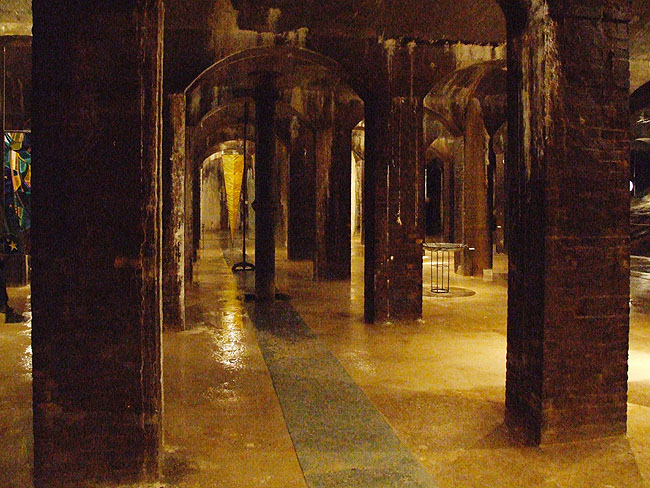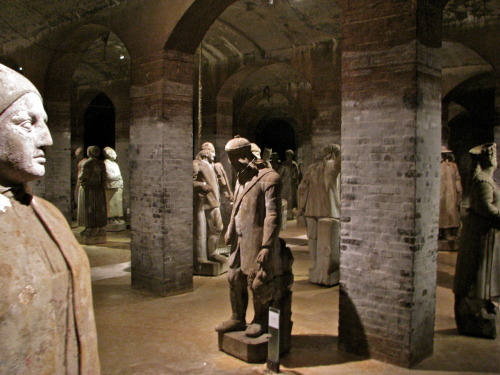It was with this in mind that I rode out to the Cisternerne Modern Glass Art museum, hidden beneath Søndermarken.
Søndermarken, translation "the southern field", is a large park on the edge of Frederiksberg, and is a typically Danish green space - dense forest, alternating with perfectly manicured lawns and gravel pathways lined with hulking trees.
On the main lawn, there are two glass protrusions which form the entrance to the museum.
As the name suggests, Cisternerne has been set up on the old cisterns of Copenhagen. Following a cholera outbreak in the 1850s, it was decided that Copenhagen needed an independent and clean water supply, and the only place in the city high enough to allow the water to be distributed to the city was up on Fredricksberg hill. The cisterns were originally built as an open-air reservoir, but at some point were enclosed, and separated into 3 separate spaces, each measuring approximately 40m x 40m, and about 4m high.
You aren't allowed to take photos inside, so the rest of the images are from people who are either better connected or less rule-governed than me.
You aren't allowed to take photos inside, so the rest of the images are from people who are either better connected or less rule-governed than me.
 |
| This is what the inside is like, only this photo has been taken with a massively long exposure, so it is nowhere near this bright. Credit: http://www.photo-gallery.dk/oversigt/kunst_kultur_&_musik/cisternerne/_cisternerne-042.html |
The atmosphere of the museum alone was worth the entrance fee. Presumably paying homage to the venues history, there was a thin film of water covering the floor (I really hope they were paying homage, because otherwise I was probably in a fairly decent amount of danger of being buried 4m beneath Copenhagen). Stalactites droop from the ceilings and the only light is that which illuminates the artworks. Every sloshing footstep echos through the cavernous halls and the tiniest noises bounce off the walls magnified. All in all it was pretty creepy.
On the topic of artwork, I am definitely no art afficionado, but I do enjoy the craftsmanship involved in glasswork. I thought/was certain that that maybe I wouldn't be able to appreciate the hidden meaning behind the art, but would be able to enjoy it nonetheless in the same way that I enjoy looking at vases at wanky homeware shops.
 |
| Oooooh, pretty vase. Credit: http://www.merchplus1.com/assets/product_images/product_lib/10000-19999/12117.jpg |
 |
| Oooooh, pretty art. Credit: http://www.visitcopenhagen.com/see-and-do/cisternerne-museum-of-modern-glass-art/382 |
There weren't very many 3D sculptures or stained glass windows, rather mostly it seemed to be pictures painted directly onto the glass and then laminated with more glass. Kind of like the cellophane paintings that kids do in kindy, only without the benefit of lines to colour in-between.
One piece was a glass tabletop, with circular mirrors stuck onto it with ping pong balls stuck onto the mirrors. And other had what was clearly a woman nursing what was not-so-clearly her child - I maintain she was holding some kind of duck-frog mutant.
 |
| This piece was actually really cool and kind of mesmerising. Credit: http://www.danishcrafts.dk/visKalenderArrangement.asp?artikelID=2475 |
 |
| Credit: http://www.weareprivate.net/blog/?p=16665 |
 |
| Credit: http://www.kulturklik.dk/steder/cisternerne-museet-for-moderne-glaskunst |
| Nb. This may not actually have been part of the museum. Credit: http://educatingapril.blogspot.dk/2011/02/art-workshop-1.html |
The last cistern however was really interesting - in the vein of the clay soldiers, they had a collection of life-sized rock carvings of nordic villagers in traditional costumes. From what I was able to glean from the description, they were from the 1700s, but considering that the description was in Danish, it could just as easily have said that they were made from 1700 tonnes of rock, or 1700 monkeys were involve in carving the statues. Regardless, they were easily my favourite artworks.
 |
| Credit: http://thecurioussoul.tumblr.com/ |
 |
| Credit: http://politiken.dk/turengaartil/guide/europa/danmark/koebenhavn/ECE1335491/loerdag-og-soendag-i-koebenhavn/ |




No comments:
Post a Comment